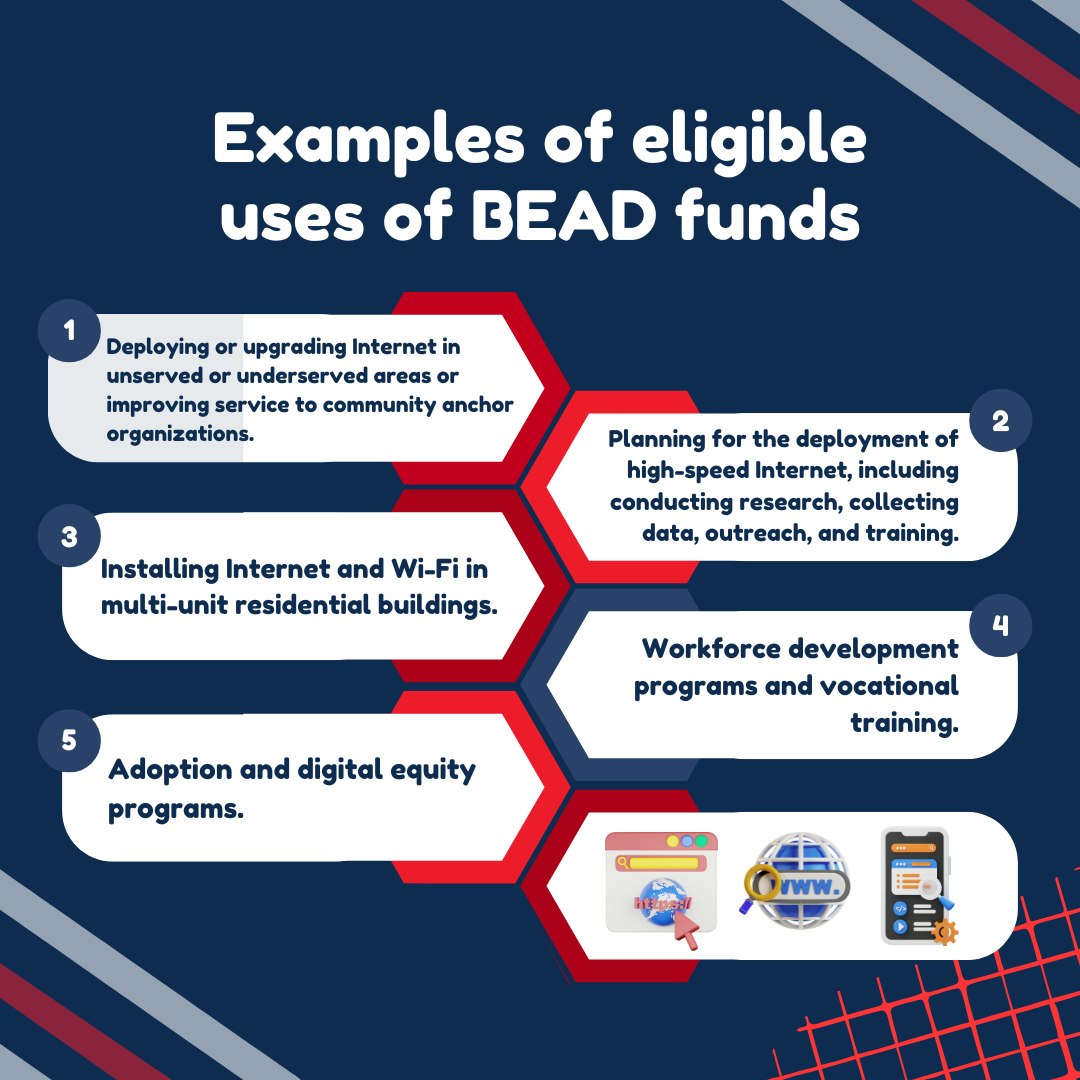Keep your state connected - the importance of BEAD funding and how Connected Nation can help
Bowling Green, Ky. (May 14, 2024) - In today's digital age, it’s easy to assume that every American can get on the internet whenever they want or need to. But the fact is, millions of people still lack access to affordable, reliable, broadband (high-speed internet). That is why the National Telecommunications and Information Administration (NTIA) is working to make reliable internet access available to all Americans through funding the Broadband Equity, Access, and Deployment (BEAD) program.
As a part of the Infrastructure Investment and Jobs Act (IIJA), the BEAD program is setting aside $42.45 billion to expand high-speed internet access by funding planning, infrastructure deployment, and adoption programs in all 50 states, Washington, D.C., Puerto Rico, the U.S. Virgin Islands, Guam, American Samoa, and the Commonwealth of the Northern Mariana Islands.
The BEAD program prioritizes unserved locations that have no internet access or that only have access under 25/3 Mbps, and underserved locations only have access under 100/20 Mbps.
“Our country runs on broadband,” said Tim LeDonne, Executive Director, State Programs, for the national nonprofit Connected Nation. “A strong internet connection not only helps fuel our communities, but also powers our economy, schools, the job market, health care, and much more. Too many Americans are cut off from the opportunities that broadband makes possible, but the BEAD funding will help each state/territory overcome this issue.”
BEAD offers more than just broadband expansion
The BEAD program is a huge catalyst for digital equity initiatives, providing everyone with access to essential technologies, despite varying economic backgrounds or situations. Although some states may administer their Digital Equity Plans differently, they still fall under the federal BEAD funding program and will be used to implement digital equity and inclusion programs across the territories and the United States.
“The equity piece of BEAD is very important,” said LeDonne. “The ‘e’ in BEAD stands for ‘equity.’ Without the e, BEAD is just B-A-D. The program has a specific focus on digital equity and creates a path for equitable participation in the digital economy so all communities can have the tools and resources necessary to benefit from a connected world.”

The BEAD program also unlocks opportunities for workforce development and vocational training by funding programs that train employees for broadband-related jobs.
“Within the next year or so, more jobs will be created by the need to support the deployment activities of BEAD,” said LeDonne. “While the workforce may not be there yet, it’s important for local governments, communities, and industry leaders to develop, implement, and promote their training programs.”
Here are other eligible uses of BEAD funds:
- Deploying or upgrading internet service in unserved or underserved areas or improving service to community anchor organizations.
- Planning for the deployment of high-speed internet, including conducting research, collecting data, and providing outreach and training.
- Installing internet and Wi-Fi in multi-unit residential buildings.
States take action
You might be wondering, how much money is allocated to each state/territory? The NTIA has broken down the exact amount of BEAD dollars per state/territory on its website. It’s now up to each state government/broadband office to develop a plan on how exactly those funds will be spent to best serve their residents. Delaware and Oklahoma are good examples.
The state of Delaware was awarded $107,748,384.66 in BEAD funding. Its State Broadband Office worked to complete a five-year action plan and two volumes of initial proposals. Once each plan is approved, the state will award funding to qualified internet service providers (ISPs). The ISPs will then deploy high-speed internet infrastructure to homes and businesses across Delaware.
Oklahoma has also started work on its plans for the BEAD funds. The state was allocated $797,435,691.25. Much like Delaware, the Oklahoma Broadband Office has created a five-year action plan that has been approved by the NTIA, as well as two volumes of initial proposals.
How Connected Nation can help
Connected Nation (CN) helps state broadband offices and other state, local, and regional leaders take the driver's seat, navigate through the funding process, and make the most of funding opportunities including BEAD.
CN’s planning efforts take a state-specific approach, combining broadband expertise, data analysis and assessment, and meaningful engagement to support communities in their work to expand broadband adoption, access, and use.
If you are a state or a local leader who is looking for help with BEAD planning, connect with us or one of our broadband strategy experts. We can provide assistance with grant administration, program design, funding strategy, implementation plans for monitoring and compliance, infrastructure field validation and outside plant audits.
Nobody should ever be left behind. Everyone belongs in a Connected Nation.
Other BEAD-related CN articles:
- Input needed - Illinois residents invited to complete broadband map challenge process
- States will have to lead when it comes to BEAD: Here’s how to make the most of billions in new federal funding
- Optimal BEAD grant theory
- Hawaii program demonstrates BEAD's ability to directly impact our nation's most vulnerable populations
About the Author: Lily McCoy is the Connected Nation Senior Communications Speacilist. Lily provides support to the Communications Department through social media outreach and writing. She also adds a source of creativity to the team with a background in personal relations and marketing. Lily has a bachelors in corporate and organizational communications from Western Kentucky University.







